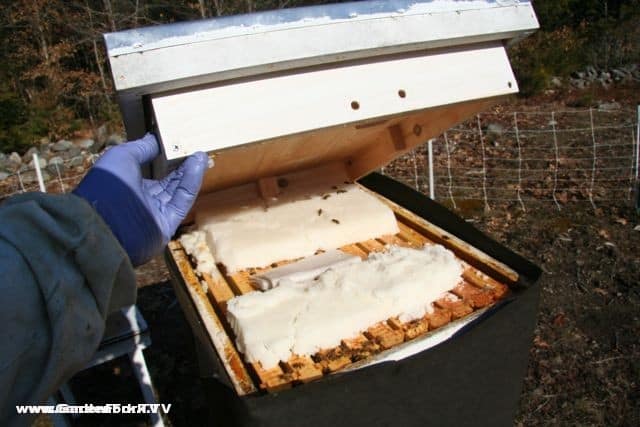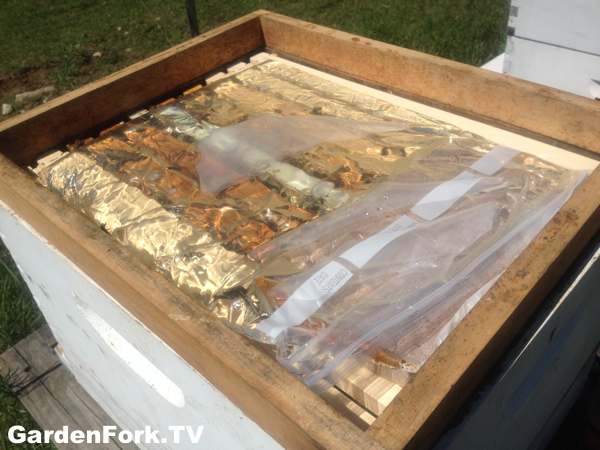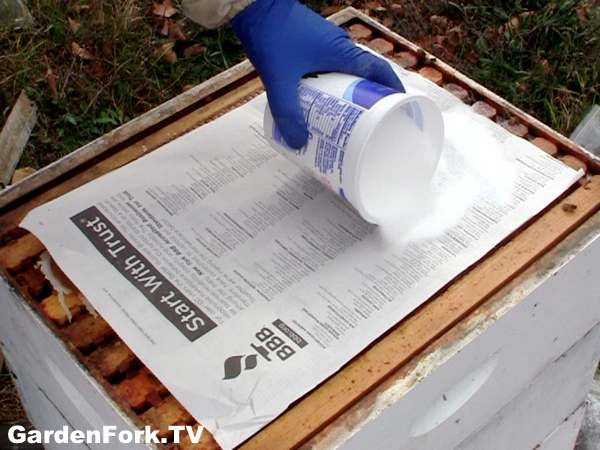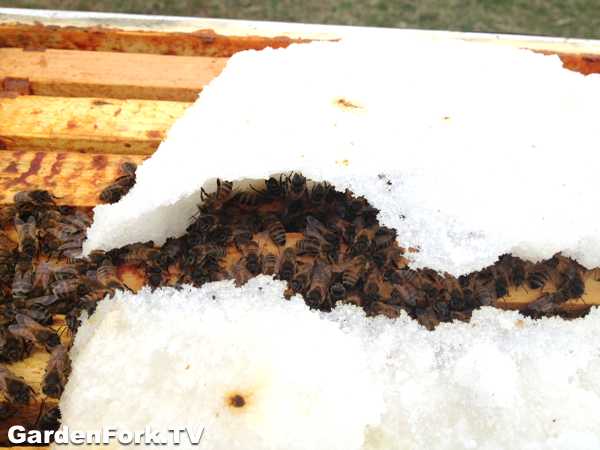The mountain camp method of feeding your bees sugar during winter is the best way I've found so far to provide bees with an emergency food source. For whatever reason, honeybees may run through their winter food stores, and need additional food to get through the tough winter months. The mountain camp method provides this back up food source in a brilliantly simple way. Watch our intro video and follow up video, then read through the rest of this beekeeping 101 post.
Mountain Camp Method How To
Before I started to use this technique, every fall I would make sugar patties for the top of the hives as an emergency feed. They work fine, but making sugar cakes is a pain. This does the same thing.
The mountain camp method of feeding honeybees emergency sugar is pretty simple. And that's why I love it. Here's how to do it:
- Lay a sheet of newspaper over the top of the hive, cutting it down so there is space around the inside perimeter of the hive box.
- Pour granulated sugar on top of the newspaper.
- Spray the pile of sugar with water so it crusts over.
- Place a spacer shim and/or an insulated inner cover over the pile of sugar.
- Tilt and strap your hives down for winter.


Insulated Inner Cover with built-in spacer for sugar feeding

Simple spacer allows for dry and wet sugar feeding. Easy to build.
This pile of sugar on top of the hive provides a second benefit, it absorbs moisture in the hive during winter, and prevents condensation from dripping back down on to the bees. Wet bees in winter is a very bad thing.
Questions I have gotten about this method:
Can I feed them this dry sugar instead of sugar syrup in the fall? No. You still need to feed the bees sugar syrup in the fall. Watch our Sugar Syrup Feed videos.
My bees have plenty of honey and I fed them sugar syrup during the fall, why do I need to do this? I do the same thing in the fall, but the dry sugar is an emergency winter feed. Sometimes bees run out of their own stores, or sometimes they can't get to them. Below is a photo of bees taking up sugar I provided them. If I hadn't provided the bees with this emergency sugar, they would be dead now.
Why is it called mountain camp? From what I understand, a person who goes by that name posted this method online a while back and the name stuck.

Build an Insulated Inner Cover
Let us know your comments below, thanks!



Vince Busche
My mountain camp feeder had sugar left over so I have saved it. To use again in winter. Or should I discard this? Also put Bee Pro/powder sugar/water in brick form in the feeder. There is also some of this left ov er.
Eric
you can re-use the sugar as long as it is clean, not sure about the Bee Pro. thx!
John and Diane
We live in South Central Alaska, just outside Anchorage. Winters are chilly here, and lengthy, though it doesnt get much below -20F where we are. We're intending to attempt wintering over and are really interested in the granular sugar emergency feeding method you describe. Because of the extended cold (continuously below freezing weather expected from late October through mid April along with very limited sunlight) and the associated very dry air, we're concerned about the bees having sufficient moisture. Any thoughts? We keep a heated water bucket for our dogs and I suppose we could do something similar for the bees, but this will take some thought.
Thanks,
John and Diane
Gary Miller
John and Diane,
Have you spoken with other beekeepers in your area to see what they do? I would be very concerned about the amount of moisture a heated water supply would produce in the hive. The freezing temp for 2:1 is -10C. You should seriously consider the mountain camp method of feeding. Sugar draws moisture from the air and will supply some moisture that way, plus you spray the dry sugar down when you place it in the hive. No need to re-invent the wheel here, find a tried and true method that works and start from there. Talk to other local beekeepers. You might also want to try the baggie method where you place the syrup in a Ziploc bag and place the bag right on top of the frames, thus keeping it closer to the warm cluster and at the same time providing all the water they need.
Mike Koss
Can you use eucalyptus oil to spritz the sugar mountain and if yes how many drops in a normal size spray bottle (like in the video) to water is safe to use? Thanks, Mike
Eric
@mike, no, sorry. at this point i would not use anything other than the essential oil mixes like Honey B Healthy. thx!
John Gordon
It’s been in the 20’s and 30’s for the last two weeks or so with another week of the same temps. If my bees are clustered will they be able to feed and keep clustered enough to survive until the weather breaks?
Eric
@John, At this point its coin toss. Its all about prepping the hives in the fall to make sure they have enough food and are healthy. I have found the bees use the dry sugar at the end of winter, early spring, when they need it most. thx!
Mary Kay
What types of essential oils do you use and have you ever tried it? I was thinking lavender or a citrus one.